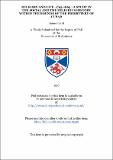Files in this item
Religion and life, 1793-1865 : a study in the social and the religious history within the bounds of the Presbytery of Cupar
Item metadata
| dc.contributor.author | Laird, James | |
| dc.coverage.spatial | 335 p. | en_US |
| dc.date.accessioned | 2018-05-29T15:19:25Z | |
| dc.date.available | 2018-05-29T15:19:25Z | |
| dc.date.issued | 1977 | |
| dc.identifier.uri | https://hdl.handle.net/10023/13596 | |
| dc.description.abstract | The population of the parishes under the supervision of the Presbytery of Cupar increased continually until 1851 aid until I841 an ever larger proportion of the inhabitants of the area found employment in the textile trade. Food prices were subject to fluctuation but while wages on the whole tended to rise the remuneration of textile workers deteriorated. Politically the Reform Act of 1832 was widely supported in the area which was transformed by it from a tory to a whig stronghold but dissatisfaction with that legislation created widespread support for the chartist movement among the unenfranchised. In 1793 the Established Church dominated the area through its nineteen Kirk Sessions but the congregations of the Secession & Relief Churches increased in member and the union of these denominations created, a body with only a few less congregations than the national church while the appearance of the Free Church made the establishment the place of worship of a minority group. Membership of these three sects was drawn from all classes of society. All the denominations engaged in the rebuilding of churches the architecture of which became increasingly elaborate as the nineteenth century advanced and architects of national fame were employed in their design. The internal equipping and appearance also underwent change as aids to comfort and beauty and revised ideas regarding the celebration of the sacrament of communion were incorporated into their structure. The financial provision for the parish churches fell on the heritors and was controlled by statute but in other denominations the generosity of the members provided for all the needs of the church. The rejection of the Westminster Confession of Faith's definition of the relationship between church and state eventually led to an attack on the Established Church's position in relation to the civil law and particular to the legal provisions for the financial support of that body. Concurrently with this attack a dispute within the establishment over the law of patronage led to the Disruption of 1843. Other disputes took place but the period was also marked by two important unions, that of the New Lights of the two branches of the Secession Church and of the United Secession and Belief Churches. Ministers and elders of all denominations shared a common background although the method of their election differed, dissenters generally being chosen by popular election, while in the parish churches the popular voice only became important after 1830. The functions of the church also underwent change. While worship followed generally the pattern set out in the Directory of Worship communion practice underwent modification and discipline relaxed appreciably. During the period, too, the responsibility for the provision of poor relief aid the supervision of education was removed from the church which became a purely religious body. | en_US |
| dc.language.iso | en | en_US |
| dc.publisher | University of St Andrews | |
| dc.subject.lcc | BX9072.L2 | en |
| dc.subject.lcsh | Cupar (Scotland)--History | en |
| dc.subject.lcsh | Religion--Scotland--History | en |
| dc.title | Religion and life, 1793-1865 : a study in the social and the religious history within the bounds of the Presbytery of Cupar | en_US |
| dc.type | Thesis | en_US |
| dc.type.qualificationlevel | Doctoral | en_US |
| dc.type.qualificationname | PhD Doctor of Philosophy | en_US |
| dc.publisher.institution | The University of St Andrews | en_US |
This item appears in the following Collection(s)
Items in the St Andrews Research Repository are protected by copyright, with all rights reserved, unless otherwise indicated.

